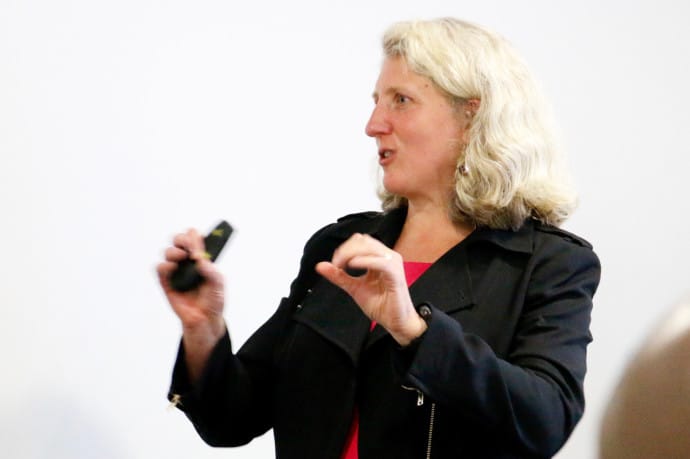“An estimated 9 million people have active tuberculosis (TB) globally – 11% of these are children – 200 million children are infected and likely to develop disease. TB remains the leading cause of death by infectious disease. South Africa has the third-highest incidence in the world – estimated at 1000 per 100 000. 74% of those infected also have HIV,” said Nicole Sampson, Professor of Chemistry at Stony Brook University and current STIAS fellow.

“In South Africa TB incidence has begun to stabilise – probably due to increased access to treatment for HIV. However, 245 people still die in South Africa every day from TB – that’s one person every six minutes!”
Sampson was talking about her project which is aimed at developing a rapid, cheaper diagnostic test for TB infection. Her research group is collaborating with clinicians at the Desmond Tutu TB Centre at Stellenbosch University.
“Diagnosis remains challenging,” she said. “The gold-standard diagnostic methods require sputum and children, in particular, cannot produce sputum.”
“The screening tests also only show exposure – they don’t distinguish between active and latent disease,” she continued. “GeneExpert, for example, looks for DNA but cannot distinguish between live or dead DNA.”
“Even with a good sputum sample it takes three weeks to diagnose because you have to grow the bacteria in the laboratory.”
“This means that children are usually diagnosed on the basis of clinical symptoms but young babies, especially, may have other upper-respiratory infections so this is not ideal.”
More sensitive, specific and, especially, child-friendly diagnostic tools are urgently needed to diagnose TB accurately.
“New tests are needed that ideally allow triage and clinic-based screening; are rapid; non-sputum based; can ascertain drug sensitivity; can predict the switch from latent to active TB; can also be used to predict the extent of illness and therefore monitor treatment; and, are non-invasive for children,” continued Sampson. “For resource-limited settings especially we need a cheap, rapid, biomarker-based test that does not require temperature control and electricity.”
“Building on our extensive biochemical foundation of how cholesterol is metabolised, my laboratory has identified potential avenues for both diagnosing TB disease more readily and for improving treatment of TB,” she said.
“We first needed to answer the question of where the mycobacteria hide in humans and how they survive,” she continued.
Mycobacterium tuberculosis (MTB) infects and divides inside human immune cells called macrophages.
“TB hides in the macrophages where it uses fats and cholesterol (low-density lipoprotein [LDL] cholesterol which is the bioavailable form) to survive. The ability of MTB to metabolise human cholesterol is critical for the maintenance of the MTB infection in these cells. The MTB modifies the LDL creating a TB lipoprotein.”
The group’s research is investigating whether this modified protein could be used as a biomarker for TB disease. The first step therefore was to find antibodies that will recognise the TB lipoprotein.
“Now that we have found suitable antibodies we will use these to create an antibody-based diagnostic assay to detect TB samples which would, hopefully, recognise the altered proteins using a small volume of blood.”
“The test would require body fluids but not necessary sputum. It would be a low-technology test in the form of a test stick that is fast, heat stable and does not require electricity. It would also be cheap – probably about $1 – 2 per patient,” added Sampson.
“We have identified 13 unique antibodies thus far – all of which recognise the TB lipoprotein. Our prototype test recognises TB lipoprotein in serum from patients with TB disease. Now the challenge is to test these against many serum samples from previous research to establish validation.”
Test and treat
It’s also hoped that the same ideas could be useful for ongoing disease monitoring and potentially for treatment.
“We are also currently studying the relationship between TB disease state and the levels of the biomolecule,” said Sampson. The idea would be to look over the longer term at whether cholesterol metabolism could be inhibited for TB treatment.”
“Current TB treatment is not straightforward – it is long with high toxicity and therefore low compliance. It requires six months of therapy often leading to other gastrointestinal and liver conditions,” continued Sampson. “Drug-resistant TB requires even longer treatment with different and more toxic drugs – it is expensive, less effective and has more side effects. In South Africa 4% of cases are drug resistant – the percentage doubled from 2013 to 2015 alone. The problem is even bigger in India, China and Russia.”
So, in addition to improved testing, we need more treatment options.
“We need to shorten the treatment times, learn to deal with persistent infection, and come up with treatment solutions for drug-resistance which was originally due to non-compliance but increasingly is showing up as primary infection.”
“I believe that funding basic biochemistry research like this is fundamental for translational work,” said Sampson. “Big Pharma won’t spend money on infectious disease research.”
“Overall, vaccines are key to eradication,” she continued, “but there has been limited success so far. You can get TB more than once so this is a challenge in vaccine development.”
“There is also no animal model that replicates TB disease in humans. We obviously cannot follow the natural history of the disease in humans – we must treat.”
“But,” she is quick to add, “diagnosis, drugs and vaccines are not the whole picture. TB is a very complex issue. Things like sanitation, healthy housing, food security and basic access to primary healthcare all have to improve.”
The decline in TB incidence in developed countries over the past hundred years has shown it is possible. “But,” said Sampson. “It has to be a truly multi-pronged, multi-disciplined global approach.”
“We must also plan for future success,” she said. “Once TB is cured it will have a profound effect on the global population.”
Words: Michelle Galloway, Part-time media officer at STIAS
Photograph: Christoff Pauw
